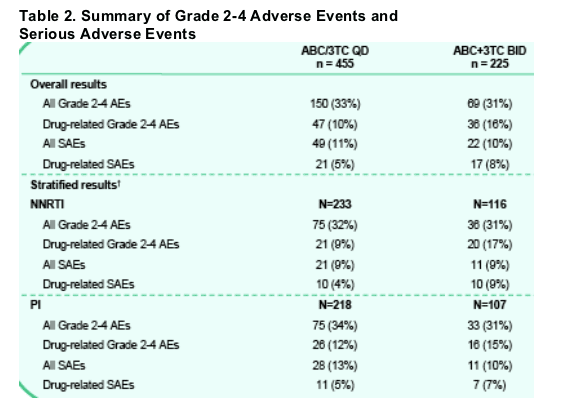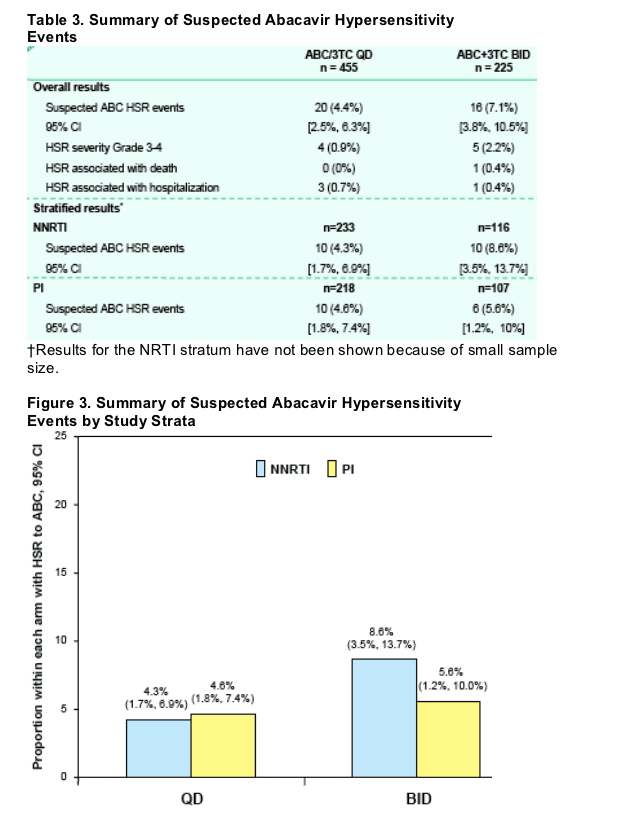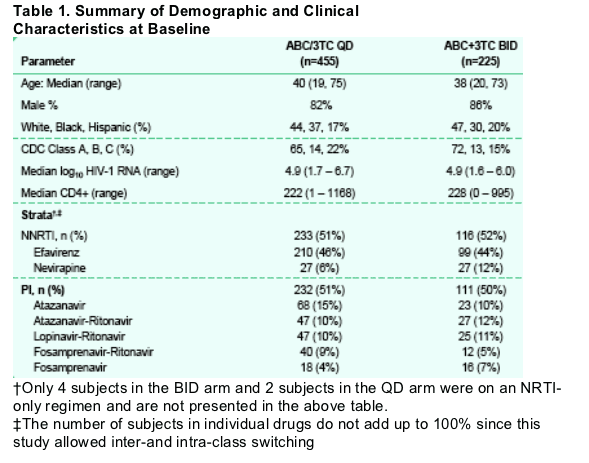 |
 |
 |
| |
Abacavir Once Daily Had Fewer HSR than Twice Daily (ALOHA Study)
|
| |
| |
Reported by Jules Levin
ICAAC, Sept 27-30, 2006, San Francisco
"Short-Term Safety and Tolerability of ABC/3TC Administered Once-daily (QD) Compared with the Separate Components Administered Twice-daily (BID): Results from ESS101822 (ALOHA)"
Marshall Kubota1, Calvin Cohen2, Anita Scribner3, Philip Brachman4, William Harley5, Vanessa Williams6, Denise Sutherland-Phillips6, Michael Lim7, Paul Wannamaker6, Rukmini Balu6, Mark Shaefer6
1The Center for HIV Prevention and Care, Santa Rosa, CA; 2Community Research Initiative, Boston, MA; 3Special Health Resources for Texas, Longview, TX; 4Atlanta ID Group, Piedmont Hospital, Atlanta, GA; 5ID Associates, Gastonia, NC; 6GlaxoSmithKline, Research Triangle Park, NC; 7GlaxoSmithKline, London, UK
".....The rates of AEs and SAEs do not appear to differ between QD and BID arms in this study. Fewer suspected hypersensitivity events were reported in the QD (4.4%) than the BID arm (7.1%). A lower proportion of HSR events in the QD arm (20%) were Grade 3/4 than in the BID arm (31%)...."
Background
Non-adherence to antiretroviral medications is associated with
virological failure, clinical disease progression and mortality; therefore good adherence to HAART is a critical determinant of its success3.
To maximize the likelihood of success, clinicians have increasingly considered adherence and adverse events (AEs) in their treatment decisions4, 5. Therapy
simplification, including reduced pill count, is a regimen-related strategy to improve adherence6.
As a once-daily (QD) fixed dose combination, abacavir/lamivudine (ABC/3TC) has shown favorable efficacy and safety in conjunction with a variety of background therapies. The tolerability of QD dosing is mostly comparable to that of ABC and 3TC administered BID. However, at least one study noted a higher rate of hypersensitivity to abacavir (ABC HSR), including severe ABC HSR in subjects on the QD versus BID regimen7.
The evaluation of safety endpoints, especially ABC HSR in a "real world" population is of particular interest, as the incidence of suspected HSR varies across studies.
The aim of the Abacavir Lamivudine Once-daily HIV Assessment (ALOHA) Study was to evaluate the short-term (12-week) safety of ABC/3TC (EPZICOM) in antiretroviral-naive subjects, when administered as a part of an investigator-selected HAART regimen. The study duration was based on the short window of time after initiation of ABC and 3TC during which safety endpoints associated with these drugs are known to occur. In addition to safety and tolerability, adherence, patient satisfaction and efficacy endpoints were also evaluated.
AUTHOR CONCLUSIONS
This study demonstrated the short-term safety and tolerability of ABC and 3TC taken once daily with a wide range of background medications in real-world clinic settings.
AE and SAE rates do not appear to be different across the two arms of the study. The observed rates of ABC HSR are consistent with the label. The data do not suggest that event rate in the QD arm is higher than that in the BID arm.
The treatment arms appear to be similar in terms of median change in HIV-1 RNA and CD4+ cells from baseline.
AUTHOR DISCUSSION and Key Study Results
The AE (adverse events) profiles were similar between the QD arm and the BID arm of the study, although a lower percentage of subjects in the QD arm experienced drug-related grade 2-4 AEs than in the BID arm: overall results-33% all grade 2-4 AEs in ABC/3TC QD (n=455) vs 31% in ABC/3TC BID (n=225); drug-related grade 2-4 AEs: 10% in QD vs 16% in BID; all SAEs (serious AEs): 11% in QD vs 10% in BID. See Table below for more details.
About half the subjects in this study were on NNRTIs and nearly a third of all subjects were on boosted PI-regimens. A larger percentage of events was observed in the NNRTI stratum of the BID arm than in any other stratum.
--Of note, a larger proportion of subjects in the BID arm were on NVP than in the QD arm (12% and 6% respectively). However, this study was not powered to formally compare treatment arms, so statistical comparisons were not conducted.
In the program abstract the authors reported the median days to onset of ABC HSR was 10.5 for QD vs 11.5 for BID. Hospitalization attributed to HSR: 0.7% in QD vs 0.4% in BID. The analysis population comprised 680 subjects (81% completed the study).
There were 36 suspected ABC HSR events in this study (Table 3), with the rates being 4.4% and 7.1% in the QD and BID arms respectively. All ABC HSR events were termed SAEs by study convention. However, only 4 events in the QD arm (0.9%) and 5 events in the BID arm (2.2%) were considered to be grade 3-4. Subjects in the NNRTI stratum of the BID arm were most likely to experience suspected ABC HSR (Figure 3). One death in the BID arm was considered to be possibly related to rechallenge ABC HSR. This subject reportedly re-started ABC upon improvement of the symptoms following initial exposure, despite being instructed by a physician to permanently discontinue the product. However it was not known whether or not the patient actually restarted ABC, or any other component of his study regimen. The final diagnoses for this subject included bilateral pneumonitis, respiratory failure requiring ventilator support, severe hypoxia secondary to adult respiratory distress syndrome (ARDS) and sepsis syndrome, and rechallenge reaction to ABC could not be ruled out.
As indicated in Figure 4, at week 12, subjects experienced a -2.69 and -2.62 median change from baseline in log10 HIV-1 RNA. The median change in CD4+ cells from baseline to week 12 was +108 and +124 cells/mm3 in the QD and BID arms respectively.
Median adherence to study drugs over 12 weeks was similar across the study arms (QD: 94.3%, BID: 92.9%). The total mean patient satisfaction scores were also similar between groups (QD: 91.7, BID 88.7) (Table 4).
Overall, the EPZICOM QD and ZIAGEN BID arms were well-tolerated with a low incidence of AEs over 12 weeks of follow-up (Table 2).



Patient Selection:
This was a Phase IIIB, randomized, open-label, parallel-arm study of HIV-1-infected adults naive to antiretroviral drugs. Patients were eligible to participate if they were naive to antiretroviral drugs at baseline and had HIV-1 RNA >1,000 copies/mL measured within three months prior to study enrollment.
Study Design:
Multicenter study conducted at 146 sites located in the United States.
Eligible subjects were randomized 2:1 to receive one of the following regimens:
ABC 600 mg/3TC 300 mg fixed dose combination tablet (FDC) (EPZICOM) administered QD, or
ABC 300 mg BID (ZIAGEN) and 3TC 150 mg BID (EPIVIR)
Choice of third agent (or fourth agent, if appropriate) to complete a HAART regimen were at the discretion of the treating physician. Based on these choices, subjects were stratified into protease inhibitor (PI), non-nucleoside reverse transcriptase inhibitor (NNRTI) and nucleoside reverse transcriptase inhibitor (NRTI) groups. These agents were assigned prior to randomization, were not considered study drugs and could be substituted or dropped during the study.
Assessments and Analysis:
Following randomization, subjects were given study drugs for 12 weeks, with study visits at baseline and at weeks 4, 8 and 12. Subjects then had the option of remaining on either the QD or BID arm or of switching to the QD arm for an additional 12 weeks (extension phase data not shown).
The primary endpoint of interest was short term AEs occurring within 12 weeks of initiating the regimens of interest. These included grade 2-4 AEs and all serious adverse events (SAEs). This study required that investigators report all ABC HSR events as SAEs, regardless of severity. Subjects with suspected ABC
HSR were required to permanently discontinue the abacavir-containing product.
HIV-1 RNA was measured at baseline and at weeks 4, 8 and 12. CD4+ cell counts were tested at baseline and at weeks 8 and 12. Laboratory assessments were conducted locally and were therefore susceptible to variability across labs and methods used for conducting the assays.
This study evaluated patient satisfaction using a validated, self-reported instrument, the status version of the HIV Treatment Satisfaction Questionnaire (HIVTSQs). The HIVTSQs was administered at week 12 or at early withdrawal.
Adherence was evaluated through pill counts of study drugs at weeks 4, 8 and 12 or at early withdrawal.
All results are descriptive, consisting of generation of frequency distributions and summary statistics. Hypothesis testing was not conducted. For rates of ABC HSR, 95% confidence intervals were generated.
RESULTS
Among 697 subjects who were randomized to either arm of the study, 680 subjects were included in the intent-to-treat exposed (ITT-E) population, which comprised the primary analysis population. Subject disposition is illustrated in Figure 2.

The distributions of demographic and clinical characteristics at baseline were similar for the two arms. Over half the subjects in this study were Black or Hispanic (Table 1). Approximately equal proportions of subjects in each arm were in the PI and NNRTI strata, with only six subjects being on
a NRTI-only regimen. A larger proportion of subjects in the BID arm took nevirapine (NVP) than in the QD arm (12% and 6% respectively).

REFERENCES
1. Willemot P, Klein MB. Prevention of HIV-associated opportunistic infections and diseases in the age of highly active antiretroviral therapy. Expert Rev Anti Infect Ther 2004; 2 (4): 521-32.
2. Palella FJ Jr, Delaney KM, Moorman AC, Loveless MO, Fuhrer J, Satten GA, Aschman DJ, Holmberg SD. Declining morbidity and mortality among patients with advanced human immunodeficiency virus infection. HIV Outpatient Study Investigators. N Engl J Med 1998; 338 (13): 853-60.
3. Bangsberg DR, Acosta EP, Gupta R, Guzman D, Riley ED, Harrigan PR, Parkin N, Deeks SG. Adherence-resistance relationships for protease and non-nucleoside reverse transcriptase inhibitors explained by virological fitness. AIDS 2006; 20 (2): 223-31.
4. Wu H, Huang Y, Acosta EP, Rosenkranz SL, Kuritzkes DR, Eron JJ, Perelson AS, Gerber JG. Modeling long-term HIV dynamics and antiretroviral response: effects of drug potency, pharmacokinetics, adherence, and drug resistance. J Acquir Immune Defic Syndr 2005; 39 (3): 272-83.
5. Dybul M, Fauci AS, Bartlett JG, Kaplan JE, Pau AK; Panel on Clinical Practices for the Treatment of HIV. Guidelines for using antiretroviral agents among HIV-infected adults and adolescents. Recommendations of the Panel on Clinical Practices for Treatment of HIV. MMWR Recomm Rep. 2002; 51 (RR-7): 1-55.
6. Clotet B, Carmena J, Pulido F, Luque I, Rodriguez-AlcantaraF. Adherence, quality of life, and general satisfaction with coformulated zidovudine, lamivudine and abacavir on antiretroviral-experienced patients. HIV Clin Trials 2004; 5 (1): 33-9.
7. Goedken AM, Herman RA. Once-daily abacavir in place of twice-daily administration. Ann Pharmacother 2005; 39 (7-8): 1302-8.
|
| |
|
 |
 |
|
|